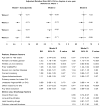Temporal trends in patient-reported angina at 1 year after percutaneous coronary revascularization in the stent era: a report from the National Heart, Lung, and Blood Institute-sponsored 1997-2006 dynamic registry
- PMID: 20031899
- PMCID: PMC3031456
- DOI: 10.1161/CIRCOUTCOMES.109.869131
Temporal trends in patient-reported angina at 1 year after percutaneous coronary revascularization in the stent era: a report from the National Heart, Lung, and Blood Institute-sponsored 1997-2006 dynamic registry
Abstract
Background: Percutaneous coronary intervention (PCI) has witnessed rapid technological advancements, resulting in improved safety and effectiveness over time. Little, however, is known about the temporal impact on patient-reported symptoms and quality of life after PCI.
Methods and results: Temporal trends in post-PCI symptoms were analyzed using 8879 consecutive patients enrolled in the National Heart, Lung, and Blood Institute-sponsored Dynamic Registry (wave 1: 1997 [bare metal stents], wave 2: 1999 [uniform use of stents], wave 3: 2001 [brachytherapy], wave 4, 5: 2004, 2006 [drug eluting stents]). Patients undergoing PCI in the recent waves were older and more often reported comorbidities. However, fewer patients across the waves reported post-PCI angina at one year (wave 1 to 5: 24%, 23%, 18%, 20%, 20%; P(trend)<0.001). The lower risk of angina in recent waves was explained by patient characteristics including use of antianginal medications at discharge (relative risk [95% CI] for waves 2, 3, 4 versus 1: 1.0 [0.9 to 1.2], 0.9 [0.7 to 1.1], 1.0 [0.8 to 1.3], 0.9 [0.7 to 1.1]). Similar trend was seen in the average quality of life scores over time (adjusted mean score for waves 1 to 5: 6.2, 6.5, 6.6 and 6.6; P(trend)=0.01). Other factors associated with angina at 1 year included younger age, female gender, prior revascularization, need for repeat PCI, and hospitalization for myocardial infarction over 1 year.
Conclusions: Favorable temporal trends are seen in patient-reported symptoms after PCI in routine clinical practice. Specific subgroups, however, remain at risk for symptoms at 1 year and thus warrant closer attention.
Figures


Similar articles
-
Twenty-year evolution of percutaneous coronary intervention and its impact on clinical outcomes: a report from the National Heart, Lung, and Blood Institute-sponsored, multicenter 1985-1986 PTCA and 1997-2006 Dynamic Registries.Circ Cardiovasc Interv. 2009 Feb;2(1):6-13. doi: 10.1161/CIRCINTERVENTIONS.108.825323. Epub 2008 Dec 15. Circ Cardiovasc Interv. 2009. PMID: 20031687 Free PMC article.
-
Risk of death and myocardial infarction in patients with peripheral arterial disease undergoing percutaneous coronary intervention (from the National Heart, Lung and Blood Institute Dynamic Registry).Am J Cardiol. 2011 Apr 1;107(7):959-64. doi: 10.1016/j.amjcard.2010.11.019. Epub 2011 Jan 20. Am J Cardiol. 2011. PMID: 21256469 Free PMC article.
-
Medical therapy in patients undergoing percutaneous coronary intervention: results from the ROSETTA registry.Can J Cardiol. 2003 Aug;19(9):1009-15. Can J Cardiol. 2003. PMID: 12915928
-
Trials and tribulations associated with angina and traditional therapeutic approaches.Clin Cardiol. 2007 Feb;30(2 Suppl 1):I16-24. doi: 10.1002/clc.20049. Clin Cardiol. 2007. PMID: 18373326 Free PMC article. Review.
-
Treatment of unstable angina pectoris/non-ST-segment elevation myocardial infarction in elderly patients.J Gerontol A Biol Sci Med Sci. 2003 Oct;58(10):M927-33. doi: 10.1093/gerona/58.10.m927. J Gerontol A Biol Sci Med Sci. 2003. PMID: 14570861 Review.
Cited by
-
Effect of multiple clinical factors on recurrent angina after percutaneous coronary intervention: A retrospective study from 398 ST-segment elevation myocardial infarction patients.Medicine (Baltimore). 2016 Oct;95(41):e5015. doi: 10.1097/MD.0000000000005015. Medicine (Baltimore). 2016. PMID: 27741110 Free PMC article.
-
Use of stress testing and diagnostic catheterization after coronary stenting: association of site-level patterns with patient characteristics and outcomes in 247,052 Medicare beneficiaries.J Am Coll Cardiol. 2013 Jul 30;62(5):439-46. doi: 10.1016/j.jacc.2013.02.093. Epub 2013 May 30. J Am Coll Cardiol. 2013. PMID: 23727207 Free PMC article.
-
Hospital-level variation in follow-up strategies after percutaneous coronary intervention, revealed in health claims data of Korea.Sci Rep. 2021 Feb 8;11(1):3322. doi: 10.1038/s41598-021-82960-4. Sci Rep. 2021. PMID: 33558600 Free PMC article.
-
Pullback Pressure Gradient-An Emerging Concept in Patients with Coronary Artery Disease.Rev Cardiovasc Med. 2024 Aug 7;25(8):278. doi: 10.31083/j.rcm2508278. eCollection 2024 Aug. Rev Cardiovasc Med. 2024. PMID: 39228493 Free PMC article. Review.
-
Prediction of Post Percutaneous Coronary Intervention Myocardial Ischaemia.Eur Cardiol. 2016 Dec;11(2):85-89. doi: 10.15420/ecr.2016:27:2. Eur Cardiol. 2016. PMID: 30310453 Free PMC article. Review.
References
-
- Williams DO, Holubkov R, Yeh W, Bourassa MG, Al Bassam M, Block PC, Coady P, Cohen H, Cowley M, Dorros G, Faxon D, Holmes DR, Jacobs A, Kelsey SF, King SB, III, Myler R, Slater J, Stanek V, Vlachos HA, Detre KM. Percutaneous coronary intervention in the current era compared with 1985–1986: the National Heart, Lung, and Blood Institute Registries. Circulation. 2000;102:2945–2951. - PubMed
-
- Venkitachalam L, Kip KE, Selzer F, Wilensky RL, Slater J, Mulukutla SR, Marroquin OC, Block PC, Williams DO, Kelsey SF for the Investigators of NHLBI-Sponsored. Twenty-Year Evolution of Percutaneous Coronary Intervention and Its Impact on Clinical Outcomes: A Report From the National Heart, Lung, and Blood Institute-Sponsored, Multicenter 1985–1986 PTCA and 1997–2006 Dynamic Registries. Circ Cardiovasc Intervent. 2009;2:6–13. - PMC - PubMed
-
- Spertus JA, Jones P, McDonell M, Fan V, Fihn SD. Health Status Predicts Long-Term Outcome in Outpatients With Coronary Disease. Circulation. 2002;106:43–49. - PubMed
-
- Parisi AF, Folland ED, Hartigan PA. A comparison of angioplasty with medical therapy in the treatment of single-vessel coronary artery disease: Veterans Affairs ACME investigators. N Engl J Med. 1992;326 :10–16. - PubMed
-
- Rinfret S, Grines CL, Cosgrove RS, Ho KKL, Cox DA, Brodie BR, Morice MC, Stone GW, Cohen DJ. Quality of life after balloon angioplasty or stenting for acute myocardial infarction : One-year results from the Stent-PAMI trial. Journal of the American College of Cardiology. 2001;38:1614–1621. - PubMed
Publication types
MeSH terms
Substances
Grants and funding
LinkOut - more resources
Full Text Sources
Miscellaneous

